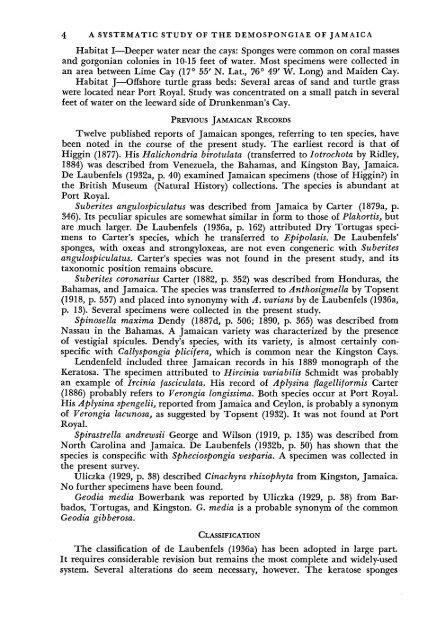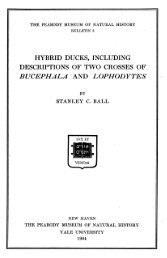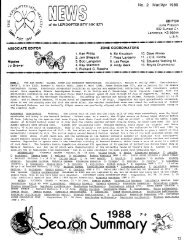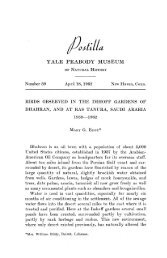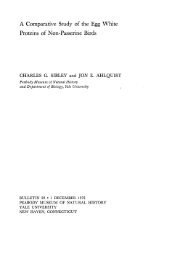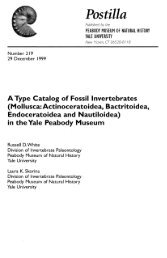Bulletin 20 - Peabody Museum of Natural History - Yale University
Bulletin 20 - Peabody Museum of Natural History - Yale University
Bulletin 20 - Peabody Museum of Natural History - Yale University
Create successful ePaper yourself
Turn your PDF publications into a flip-book with our unique Google optimized e-Paper software.
4 A SYSTEMATIC STUDY OF THE DEMOSPONGIAE OF JAMAICA<br />
Habitat I—Deeper water near the cays: Sponges were common on coral masses<br />
and gorgonian colonies in 10-15 feet <strong>of</strong> water. Most specimens were collected in<br />
an area between Lime Cay (17° 55' N. Lat., 76° 49' W. Long) and Maiden Cay.<br />
Habitat J—Offshore turtle grass beds: Several areas <strong>of</strong> sand and turtle grass<br />
were located near Port Royal. Study was concentrated on a small patch in several<br />
feet <strong>of</strong> water on the leeward side <strong>of</strong> Drunkenman's Cay.<br />
PREVIOUS JAMAICAN RECORDS<br />
Twelve published reports <strong>of</strong> Jamaican sponges, referring to ten species, have<br />
been noted in the course <strong>of</strong> the present study. The earliest record is that <strong>of</strong><br />
Higgin (1877). His Halichondria birotulata (transferred to Iotrochota by Ridley,<br />
1884) was described from Venezuela, the Bahamas, and Kingston Bay, Jamaica.<br />
De Laubenfels (1932a, p. 40) examined Jamaican specimens (those <strong>of</strong> Higgin?) in<br />
the British <strong>Museum</strong> (<strong>Natural</strong> <strong>History</strong>) collections. The species is abundant at<br />
Port Royal.<br />
Suberites angulospiculatus was described from Jamaica by Carter (1879a, p.<br />
346). Its peculiar spicules are somewhat similar in form to those <strong>of</strong> Plakortis, but<br />
are much larger. De Laubenfels (1936a, p. 162) attributed Dry Tortugas specimens<br />
to Carter's species, which he transferred to Epipolasis. De Laubenfels'<br />
sponges, with oxeas and strongyloxeas, are not even congeneric with Suberites<br />
angulospiculatus. Carter's species was not found in the present study, and its<br />
taxonomic position remains obscure.<br />
Suberites coronarius Carter (1882, p. 352) was described from Honduras, the<br />
Bahamas, and Jamaica. The species was transferred to Anthosigmella by Topsent<br />
(1918, p. 557) and placed into synonymy with A. varians by de Laubenfels (1936a,<br />
p. 13). Several specimens were collected in the present study.<br />
Spinosella maxima Dendy (1887d, p. 506; 1890, p. 365) was described from<br />
Nassau in the Bahamas. A Jamaican variety was characterized by the presence<br />
<strong>of</strong> vestigial spicules. Dendy's species, with its variety, is almost certainly conspecific<br />
with Callyspongia plicvfera, which is common near the Kingston Cays.<br />
Lendenfeld included three Jamaican records in his 1889 monograph <strong>of</strong> the<br />
Keratosa. The specimen attributed to Hircinia variabilis Schmidt was probably<br />
an example <strong>of</strong> Ircinia fasciculata. His record <strong>of</strong> Aplysina flagelliformis Carter<br />
(1886) probably refers to Verongia longissima. Both species occur at Port Royal.<br />
His Aplysina spengelii, reported from Jamaica and Ceylon, is probably a synonym<br />
<strong>of</strong> Verongia lacunosa, as suggested by Topsent (1932). It was not found at Port<br />
Royal.<br />
Spirastrella andrewsii George and Wilson (1919, p. 135) was described from<br />
North Carolina and Jamaica. De Laubenfels (1932b, p. 50) has shown that the<br />
species is conspecific with Spheciospongia vesparia. A specimen was collected in<br />
the present survey.<br />
Uliczka (1929, p. 38) described Cinachyra rhizophyta from Kingston, Jamaica.<br />
No further specimens have been found.<br />
Geodia media Bowerbank was reported by Uliczka (1929, p. 38) from Barbados,<br />
Tortugas, and Kingston. G. media is a probable synonym <strong>of</strong> the common<br />
Geodia gibberosa.<br />
CLASSIFICATION<br />
The classification <strong>of</strong> de Laubenfels (1936a) has been adopted in large part.<br />
It requires considerable revision but remains the most complete and widely-used<br />
system. Several alterations do seem necessary, however. The keratose sponges


